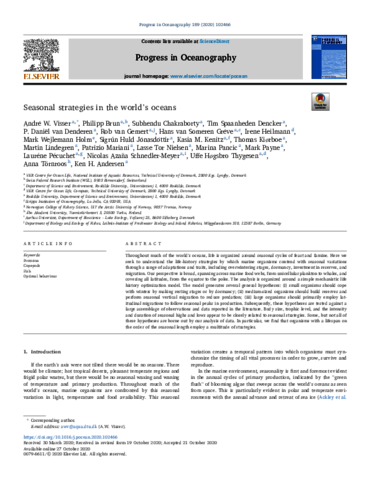Throughout much of the world’s oceans, life is organized around seasonal cycles of feast and famine. Here we seek to understand the life-history strategies by which marine organisms contend with seasonal variations through a range of adaptations and traits, including overwintering stages, dormancy, investment in reserves, and migration. Our perspective is broad, spanning across marine food webs, from unicellular plankton to whales, and covering all latitudes, from the equator to the poles. The analysis is organized around a simple mechanistic life history optimization model. The model generates several general hypotheses: (i) small organisms should cope with winters by making resting stages or by dormancy; (ii) medium-sized organisms should build reserves and perform seasonal vertical migration to reduce predation; (iii) large organisms should primarily employ latitudinal migrations to follow seasonal peaks in production. Subsequently, these hypotheses are tested against a large assemblage of observations and data reported in the literature. Body size, trophic level, and the intensity and duration of seasonal highs and lows appear to be closely related to seasonal strategies. Some, but not all of these hypotheses are borne out by our analysis of data. In particular, we find that organisms with a lifespan on the order of the seasonal length employ a multitude of strategies.
Seasonal strategies in the world’s oceans
Rezensierter Artikel

Visser, A. W., Brun, P., Chakraborty, S., Spaanheden Dencker, T., Van Denderen, P. D., Van Gemert, R., Van Someren Gréve, H., Heilmann, I., Holm, M. W., Jónasdóttir, S. H., Kenitz, K. M., Kiørboe, T., Lindegren, M., Mariani, P., Nielsen, L. T., Pancic, M., Payne, M., Pécuchet, L., Schnedler-Meyer, N. A., Thygesen, U. H., Törnroos, A., Andersen, K. H. (2020). Seasonal strategies in the world’s oceans. Progress in Oceanography 189, 102466
Veröffentlicht
: 2020
Erschienen in
: Progress in Oceanography 189, 102466
